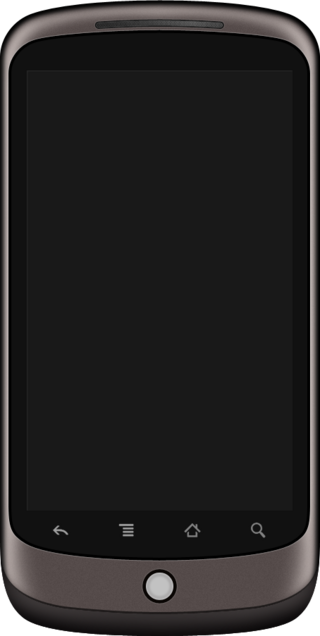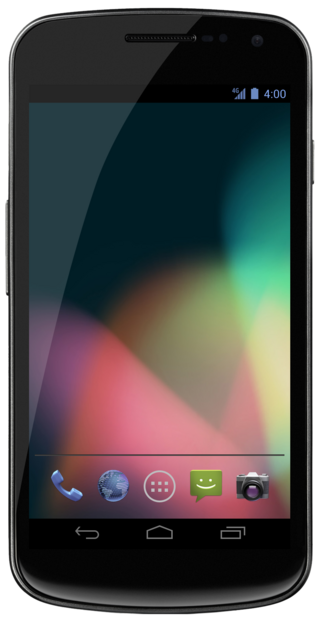
Motorola Mobility LLC, marketed as Motorola, is an American consumer electronics manufacturer primarily producing smartphones and other mobile devices running Android. Headquartered at Merchandise Mart in Chicago, Illinois, it is a subsidiary of the Chinese technology company Lenovo.

The Nexus One is an Android smartphone designed and manufactured by HTC as Google's first Nexus smartphone. The Nexus became available on January 5, 2010, and features the ability to transcribe voice to text, an additional microphone for dynamic noise suppression, and voice guided turn-by-turn navigation to drivers.

The Motorola Cliq is an Android-based smartphone by Motorola.
Google Nexus is a discontinued line of consumer electronic devices that run the Android operating system. Google managed the design, development, marketing, and support of these devices, but some development and all manufacturing were carried out by partnering with original equipment manufacturers (OEMs). Alongside the main smartphone products, the line also included tablet computers and streaming media players; the Nexus started out in January 2010 and reached its end in October 2016, replaced by Google Pixel.
The version history of the Android mobile operating system began with the public release of its first beta on November 5, 2007. The first commercial version, Android 1.0, was released on September 23, 2008. The operating system is developed by Google on a yearly cycle since at least 2011. New major releases are announced at Google I/O along with its first public beta to supported Google Pixel devices. The stable version is then released later in the year.

The Motorola Droid 3 is a smartphone released on July 7, 2011, by Verizon Wireless running the Android 2.3 operating system by Google. It comes with 16 GB of internal storage. The smartphone does not ship with a microSD card. It has a 4-inch qHD display and an 8-megapixel camera capable of recording 1080p video. Unlike the Droid 2, the Motorola Droid 3 features a 5-row QWERTY keyboard, with a dedicated number row. It also has a VGA front-facing camera for video calls. The Droid 3 ships with Android 2.3.4 (Gingerbread) with Motorola's updated proprietary Motoblur UI. Like other contemporary Motorola phones, it has a locked bootloader, but TWRP can be installed using the SafeStrap exploit, which allows custom ROMs to be installed. The GSM/UMTS version of the Droid 3 was known as the Milestone 3.

The Galaxy Nexus (GT-I9250) is a touchscreen Android smartphone co-developed by Google and Samsung Electronics. It is the third smartphone in the Google Nexus series, a family of Android consumer devices built by an original equipment manufacturer partner. The phone is the successor to Google's previous flagship phones, the Nexus One and Nexus S.

The second-generation Nexus 7, also commonly referred to as the Nexus 7 (2013), is a mini tablet computer co-developed by Google and Asus that runs the Android operating system. It is the second of three tablets in the Google Nexus tablet series, the Nexus family including both phones and tablets running essentially stock Android which were originally marketed for developer testing but later marketed by Google to consumers as well, all of which were built by various original equipment manufacturer partners. Following the success of the original Nexus 7, this second generation of the device was released on July 26, 2013, four days earlier than the originally scheduled date due to early releases from various retailers. The tablet was the first device to ship with Android 4.3.

Nexus 5 is an Android smartphone sold by Google and manufactured by LG Electronics. It is the fifth generation of the Nexus series, succeeding the Nexus 4. It was unveiled on October 31, 2013 and served as the launch device for Android 4.4 "KitKat", which introduced a refreshed interface, performance improvements, greater Google Now integration, and other changes. Much of the hardware is similar to the LG G2 which was also made by LG and released earlier that year.

AOKP, short for Android Open Kang Project, is an open-source replacement distribution for smartphones and tablet computers based on the Android mobile operating system. The name is a play on the word kang and AOSP. The name was a joke, but it stuck. It was started as free and open-source software by Roman Birg based on the official releases of Android Open Source Project by Google, with added original and third-party code, features, and control.

The Nexus 9 is a tablet computer co-developed by Google and HTC that runs the Android operating system. It is the fourth tablet in the Google Nexus series, a family of Android consumer devices marketed by Google and built by an OEM partner. The device is available in two storage sizes, 16 GB for US$399 and 32 GB for US$479. Along with the Nexus 6 mobile phone and Nexus Player digital media device, the Nexus 9 launched with 5.0 Lollipop, which offered several new features, notably a modified visual appearance, and the complete replacement of the Dalvik virtual machine with ART. Google has included an additional step to "Enable OEM unlock" before users can unlock the Nexus 9 bootloader.

Android Lollipop is the fifth major version of the Android mobile operating system developed by Google and the 12th version of Android, spanning versions between 5.0 and 5.1.1. Unveiled on June 25, 2014 at the Google I/O 2014 conference, it became available through official over-the-air (OTA) updates on November 12, 2014, for select devices that run distributions of Android serviced by Google. Its source code was made available on November 3, 2014. The first phone with Android Lollipop was the Nexus 6.

Android One is a family of third-party Android smartphones promoted by Google. In comparison to many third-party Android devices, which ship with a manufacturer's customized user interface and bundled apps, these devices run near-stock versions of Android with limited modifications, and a focus on Google services. Devices that run Android One receive OS updates for at least two years after their release, and security patches for at least three years.

The Shield Tablet, later relaunched as the Shield Tablet K1, is a gaming tablet, developed by Nvidia and released on July 29, 2014. It was Nvidia's second portable gaming device that uses Android. Compared to the Shield Portable, the controller is not permanently connected to the screen, rather it can be purchased separately. Up to four controllers can be wirelessly connected at the same time. While the Shield tablet features an 8-inch 1920×1200 pixel display, it can output 4K resolution signal to a television via HDMI.

The second generation Moto X, marketed as moto X and referred to in the media as Moto X (2014), is an Android smartphone developed by Motorola Mobility. Released on September 5, 2014, it is the successor to the original Moto X released in 2013. It was succeeded by the third generation Moto X Style and Play family, announced on July 29, 2015.

The third-generation Moto G is an Android smartphone developed by Lenovo's subsidiary Motorola Mobility, unveiled in India on July 28, 2015 and released the same day. The Moto G4 is its successor.

Moto X Play is an Android smartphone developed by Motorola Mobility, a subsidiary of Lenovo. Unveiled on July 28, 2015, it was one of three devices that succeeded the second-generation Moto X. In contrast to the high-end Moto X Style, the Play is a mid-range device distinguished by its high battery capacity.

Android Nougat is the seventh major version and 14th original version of the Android operating system. First released as an alpha test version on March 9, 2016, it was officially released on August 22, 2016, with Nexus devices being the first to receive the update. The LG V20 was the first smartphone released with Nougat.
The Pixel and Pixel XL are a pair of Android smartphones designed, developed, and marketed by Google as part of the Google Pixel product line, succeeding the Nexus line of smartphones. They were officially announced on October 4, 2016 at the Made by Google event and released in the United States on October 20. On October 4, 2017, they were succeeded by the Pixel 2 and Pixel 2 XL.

Moto X4 is an Android smartphone developed by Motorola Mobility, a subsidiary of Lenovo. Unveiled on August 31, 2017, at IFA, it is a revival of the previously discontinued Moto X line. It was released in Europe at the end of September 2017.

















